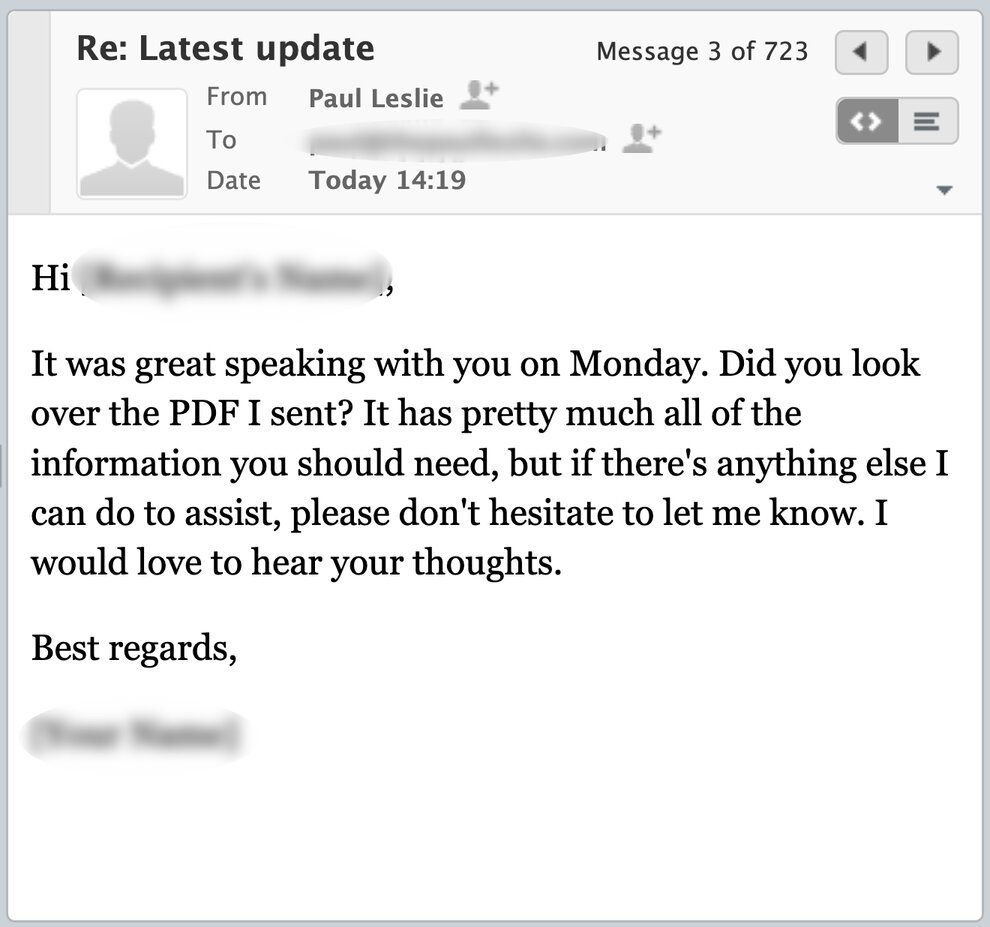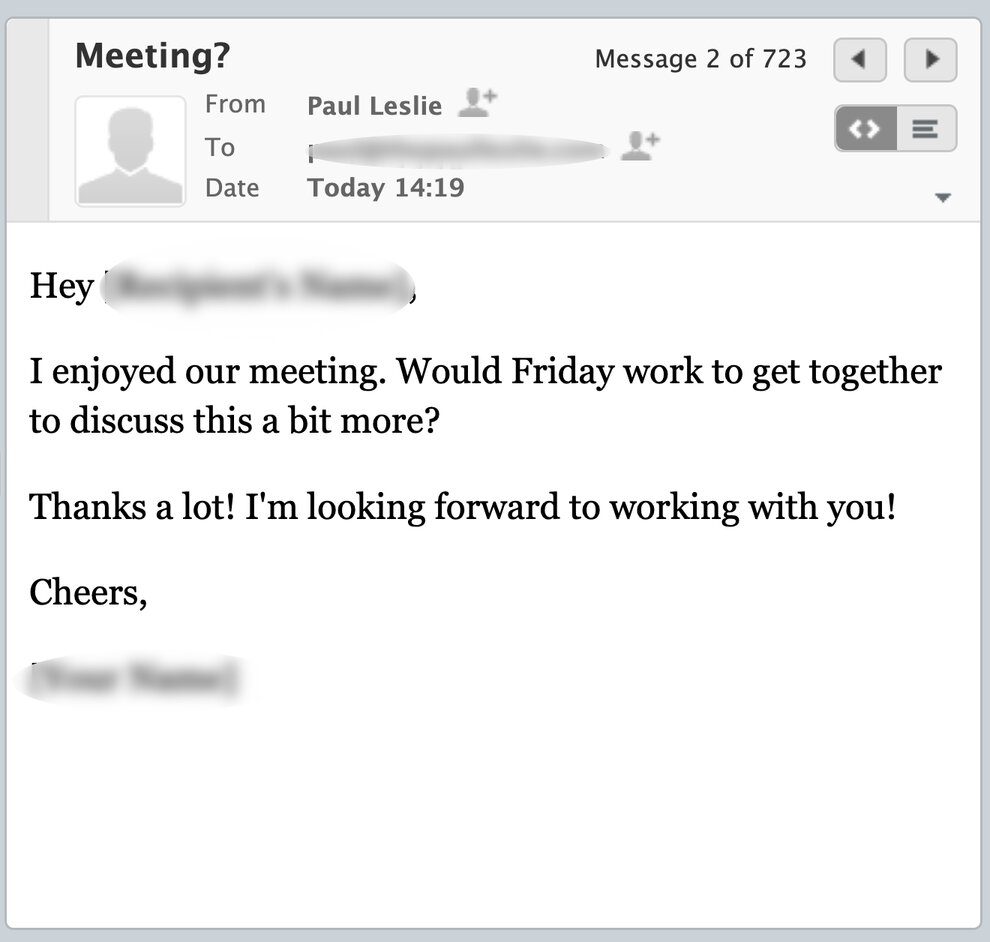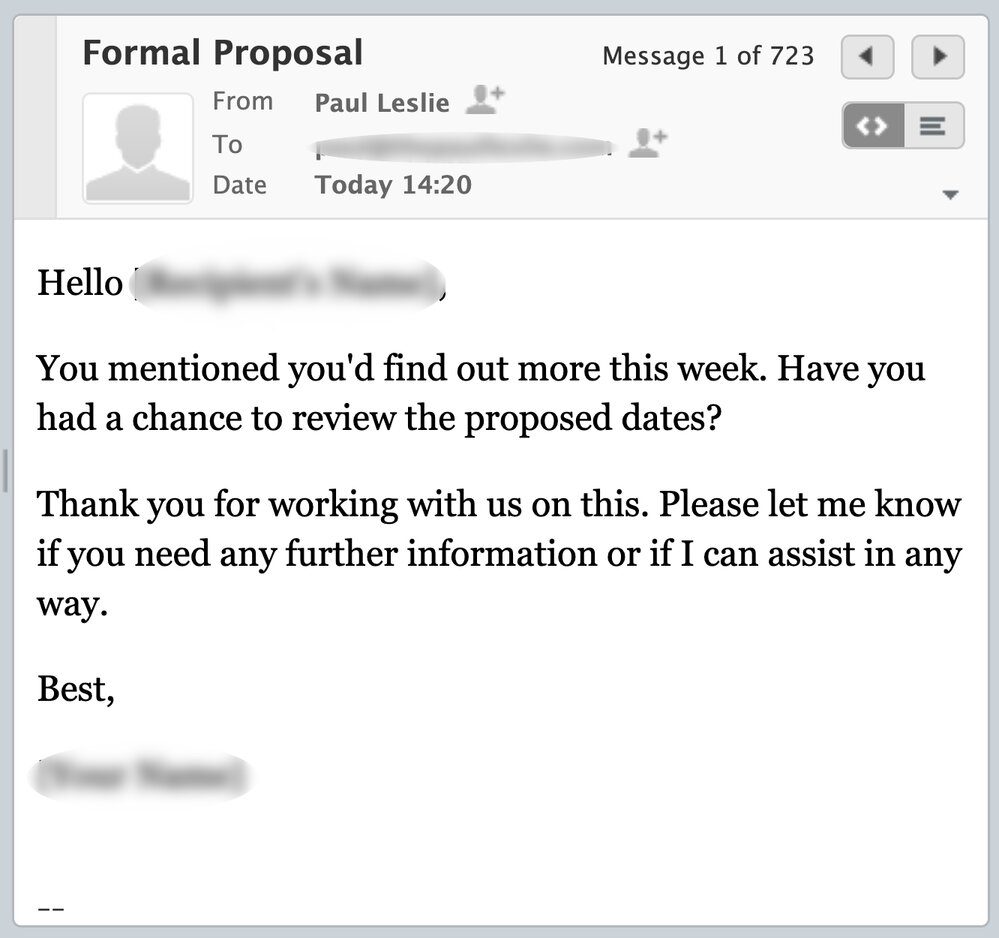
How to Write a Quick Follow-Up Email
You want to send a quick follow-up email because you didn’t hear back one way or the other. So, why is that a tad intimidating? We don’t want to come across as a nag or overly pushy, but at the same time, we’ve got to get things done.
Below we’ll show you how to write a quick follow-up email, which will bring you one step closer to achieving the results you seek.
Why should you send a quick follow-up email?
There are many reasons why you might want to send a follow-up email:
- You might have proposed a potential date and time for a meeting and haven’t heard back.
- Perhaps you sent some information and want to answer any related questions.
- You may be a public relations professional who sent a pitch and you’d like to follow up with the journalist.
- Maybe you work in real estate, and you’re waiting for your clients to confirm whether they’re interested in a property.
The reasons are endless, but you’re planning to write a quick follow-up email because you want to either obtain more information or initiate the next step: whether that’s a meeting, a sale, or to verify something.
What to avoid when writing a quick follow-up email
When following-up via email, there are some overused phrases that you want to avoid.
Think about how many emails you likely get that begin with some version of this:
- I wanted to follow up with you about…
- Just following up to see if…
- Wanted to check in with you about…
- I’m checking in to see if…
- I’m circling back to see if…
In a way it makes sense to write these things because you are checking in, and you’ve been conditioned that this is how you follow-up. It’s so common that it’s repetitive. It’s so repetitive that the words lose a lot of their meaning. So if you want to get better results, you’ll need a better approach.
How to nail the key elements of a follow-up email
Writing an effective follow-up email involves a balance of PCP:
- Politeness
- Clarity
- Purpose
If you tick these three boxes, you’re more likely to hear back from the person you’re reaching out to. Let’s get into more detail below.
Provide context
Start by briefly reminding the recipient of your previous interaction, providing context without being overly detailed. You want to show the person you’re respectful and value their time.
Use short and specific language
Use a polite and professional tone to express your intent. However, avoid overused phrases like “just checking in” or “circling back.”
Instead, opt for specific language that clearly states your reason for following up and what you’d like to achieve. Also, keep the email concise and to the point, so your recipient can easily understand your message and respond.
End with a call-to-action
End with a courteous call-to-action, such as requesting a reply or confirming the next steps, and express your appreciation for their time. Sometimes the CTA can be phrased like a question, such as “Do you think an answer would be possible by the end of the week?”
This approach not only helps you avoid being perceived as pushy, but also increases the likelihood of receiving a positive response.
Examples of quick follow-up emails you can send
By now you should have a pretty good idea of how to quickly follow up on an email. To help you save time on your outreach, let’s go a step further and look at some actual examples of email follow-ups.
Example 1: Professional follow-up email
Hi [Recipient’s Name],
It was great speaking with you on Monday!
Did you look over the PDF I sent? It has pretty much all of the information you should need, but if there’s anything else I can do to assist, please don’t hesitate to let me know. ?
I’d love to hear your thoughts.
Best regards,
[Your Name]

Example 2: Friendly follow-up email
Hey [Recipient’s Name],
I enjoyed meeting with you. Would Friday work to get together to discuss this a bit more?
Thanks a lot! I’m looking forward to working with you!
Cheers,
[Your Name]

Example 3: Follow-up email about a meeting
Hello [Recipient’s Name],
You mentioned you’d find out more this week. Have you had a chance to review the proposed dates?
Thank you for working with us on this. Please let me know if you need any further information or if I can be of assistance in any way.
Best,
[Your Name]

How many times should you follow-up?
It’s always a possibility: you follow-up and all you hear is crickets. What should you do in that case?
Here’s where you have to use some common sense. In general, you don’t want to follow up more than twice.
That said, there are times you may have nothing to lose. In certain situations, you’ll be glad you sent that third email because it gets the result you want.
However, anything more than three email follow-ups likely means you’re wasting your time. At that point, you should move on to the next idea.
Also, make sure you’re not following up on consecutive days. Of course there may be an exception, like if you’re quickly approaching a deadline. You don’t want someone to come back from taking a trip or getting a medical procedure and see a deluge of emails from you.
It’s wise to avoid being a nuisance. However, you can’t give up too easily. Common sense should prevail, but it also doesn’t hurt to try a different communication tactic. If you need an answer, don’t be afraid to pick up the phone and call them.
Sent is better than lingering in the drafts folder
You know what follows getting results? Checking things off? Do you know what ultimately leads to success?
ACTION.
By all means, make sure your follow-up emails are in good shape before you hit send. But the most important thing is that you send them. I always like to say that one sent email is worth a dozen wasting away in the drafts folder.
Review your emails before sending – and of course it pays to be careful – but don’t overthink it. Learn to use the quick follow-up email for all of its benefits: finding out the answer to your question, getting results, and making things happen.
Table of Contents
- Why should you send a quick follow-up email?
- What to avoid when writing a quick follow-up email
- How to nail the key elements of a follow-up email
- Provide context
- Use short and specific language
- End with a call-to-action
- Examples of quick follow-up emails you can send
- Example 1: Professional follow-up email
- Example 2: Friendly follow-up email
- Example 3: Follow-up email about a meeting
- How many times should you follow-up?
- Sent is better than lingering in the drafts folder






